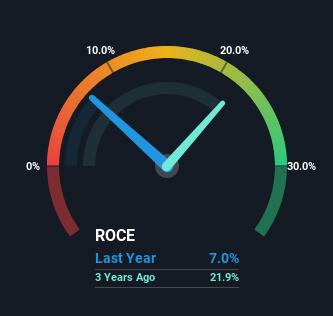Returns On Capital At PBG (BVMF:PTBL3) Have Hit The Brakes
To find a multi-bagger stock, what are the underlying trends we should look for in a business? Typically, we'll want to notice a trend of growing return on capital employed (ROCE) and alongside that, an expanding base of capital employed. Put simply, these types of businesses are compounding machines, meaning they are continually reinvesting their earnings at ever-higher rates of return. Although, when we looked at PBG (BVMF:PTBL3), it didn't seem to tick all of these boxes.
Return On Capital Employed (ROCE): What Is It?
For those who don't know, ROCE is a measure of a company's yearly pre-tax profit (its return), relative to the capital employed in the business. Analysts use this formula to calculate it for PBG:
Return on Capital Employed = Earnings Before Interest and Tax (EBIT) ÷ (Total Assets - Current Liabilities)
0.07 = R$140m ÷ (R$3.3b - R$1.4b) (Based on the trailing twelve months to December 2024).
So, PBG has an ROCE of 7.0%. In absolute terms, that's a low return and it also under-performs the Building industry average of 10%.
View our latest analysis for PBG

While the past is not representative of the future, it can be helpful to know how a company has performed historically, which is why we have this chart above. If you want to delve into the historical earnings , check out these free graphs detailing revenue and cash flow performance of PBG.
So How Is PBG's ROCE Trending?
In terms of PBG's historical ROCE trend, it doesn't exactly demand attention. The company has employed 63% more capital in the last five years, and the returns on that capital have remained stable at 7.0%. Given the company has increased the amount of capital employed, it appears the investments that have been made simply don't provide a high return on capital.
On a separate but related note, it's important to know that PBG has a current liabilities to total assets ratio of 41%, which we'd consider pretty high. This effectively means that suppliers (or short-term creditors) are funding a large portion of the business, so just be aware that this can introduce some elements of risk. While it's not necessarily a bad thing, it can be beneficial if this ratio is lower.
Our Take On PBG's ROCE
In summary, PBG has simply been reinvesting capital and generating the same low rate of return as before. Although the market must be expecting these trends to improve because the stock has gained 93% over the last five years. But if the trajectory of these underlying trends continue, we think the likelihood of it being a multi-bagger from here isn't high.
PBG does have some risks, we noticed 3 warning signs (and 2 which are significant) we think you should know about.
While PBG may not currently earn the highest returns, we've compiled a list of companies that currently earn more than 25% return on equity. Check out this free list here.
Have feedback on this article? Concerned about the content? Get in touch with us directly. Alternatively, email editorial-team (at) simplywallst.com.
This article by Simply Wall St is general in nature. We provide commentary based on historical data and analyst forecasts only using an unbiased methodology and our articles are not intended to be financial advice. It does not constitute a recommendation to buy or sell any stock, and does not take account of your objectives, or your financial situation. We aim to bring you long-term focused analysis driven by fundamental data. Note that our analysis may not factor in the latest price-sensitive company announcements or qualitative material. Simply Wall St has no position in any stocks mentioned.
 Index Options
Index Options CME Group
CME Group Nasdaq
Nasdaq Cboe
Cboe TradingView
TradingView Wall Street Journal
Wall Street Journal